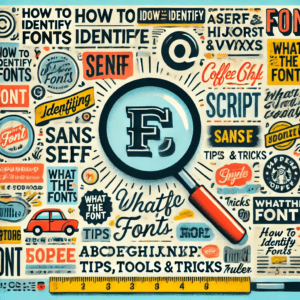How to Identify a Font: Become a Font Detective in 5 Steps

Introduction to Identify a Font
Ever seen a font that just speaks to you? Maybe it’s the one on that coffee shop menu or the cover of a magazine. Fonts are everywhere, shaping how we feel about a message before we even read it. Sometimes, though, tracking down that exact font feels like trying to remember a song title when all you know is the beat. Welcome to the world of font spotting! Here’s how you can play font detective and uncover the style that’s caught your eye.
The Art of Font Spotting: (with a Dash of Detective Work!)
When you want to identify a font, it’s all about observation. Fonts have unique characteristics—some are slender, some are bold, some have playful curls, and others mean business with straight lines and solid forms. Here’s a quick guide to some traits to look out for:
Serifs or No Serifs?
Serif fonts have little “feet” at the ends of letters (think Times New Roman), while sans-serif fonts go barefoot (like Arial). It’s a simple clue but often a useful first step.
Weight and Width
Is the font skinny, wide, or chunky? Fonts come in all sizes and shapes. Helvetica, for instance, has a bit of a sturdy, dependable look, while something like Bodoni brings a sense of elegance with its high contrast between thick and thin lines.
Curves and Corners
Curved fonts like Brush Script have a more playful, human quality, while sharp-cornered fonts feel modern and sleek.
Imagine font spotting as a bit like identifying dog breeds: once you start looking closely, you’ll notice the differences. (Comic Sans? Definitely the quirky Pomeranian of fonts.)
Tools to Help You Out
Sometimes you need backup. Thankfully, font identification tools are ready to help. Here are some tried-and-true digital sidekicks:
1. WhatTheFont
Upload a clear image of the font, and WhatTheFont will do its magic, matching your image to its database. Think of it as the friend who never forgets a face.
2. FontSquirrel Matcherator
Another solid choice, especially if you want to find a free font that’s close to what you’ve seen. FontSquirrel Matcherator is like the friend who knows all the budget hacks!
3. Identifont
If you don’t have a picture of the font, Identifont works by asking a series of questions. “Is the ‘Q’ tail straight or curly?” This tool is a bit like the friendly detective who won’t rest until they find the answer.
DIY Font Detective Skills
Sometimes, you don’t have a fancy tool or app handy—so put your DIY skills to work! Here are some tried-and-true font-hunting methods:
1. Snap a Good Reference Photo
If you’re taking a picture of a font, make it clear and straight on. Blurry, tilted photos are hard to match. Get as clear a shot as possible, and if it’s on a screen, try to avoid glare.
2. Compare Unique Letters
Fonts have “tells”—quirks that make them recognizable. Take note of unique letter shapes, especially letters like “a,” “g,” and “Q.” For instance, a lowercase “g” with a rounded shape might point you to Arial, while a more decorative one could lead you to identify a font named Garamond.
3. Match Styles and Mood
Think about the “vibe” of the font. Does it look like it belongs on a formal invitation or a sports jersey? Sometimes categorizing a font’s personality can help narrow down the options, and help you identify a font.
Mastering the Font Game
Identifying fonts may seem like a niche skill, but it’s a valuable one—especially in the world of print and design. Spotting fonts is not only fun; it helps you understand the mood of a design and communicate it better. So next time you see a font that you just have to know more about, give these tips a try! Soon, you’ll be the font aficionado among your friends—like a design superpower in your back pocket.
Happy font spotting!
For more tips and tricks, visit our blogs on our Featured Projects page.
